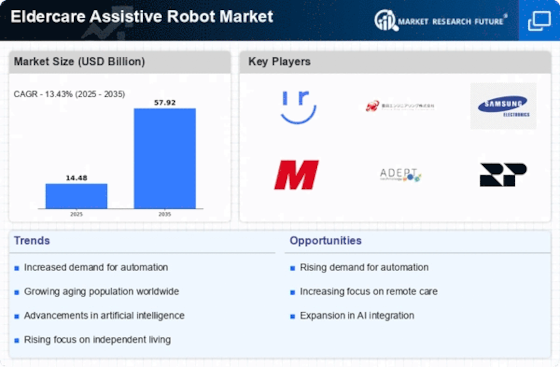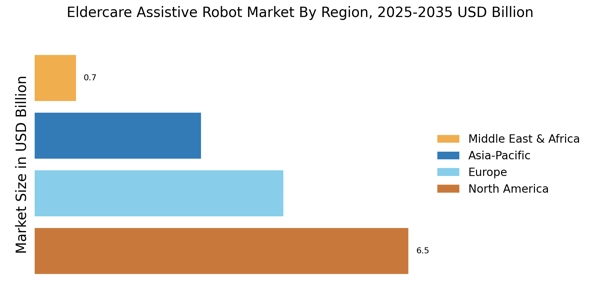Aging Population
The aging population is a primary driver of the Eldercare Assistive Robot Market. As the demographic shift towards older adults continues, the demand for innovative solutions to support their daily living needs increases. By 2030, it is projected that nearly 1 in 6 people will be aged 60 years or older. This demographic trend necessitates the development of assistive technologies that can enhance the quality of life for seniors. Eldercare assistive robots can provide companionship, assist with mobility, and help manage health conditions, thereby addressing the unique challenges faced by this population. The growing prevalence of chronic diseases among older adults further amplifies the need for these robotic solutions, as they can facilitate remote monitoring and timely interventions, ultimately improving health outcomes.
Rising Healthcare Costs
Rising healthcare costs are a significant factor influencing the Eldercare Assistive Robot Market. As healthcare expenses continue to escalate, families and healthcare providers are seeking cost-effective solutions to manage eldercare. Assistive robots can reduce the burden on caregivers and healthcare systems by providing support in daily activities, thereby minimizing the need for extensive human intervention. The potential for these robots to lower overall healthcare costs is substantial, as they can help prevent hospitalizations and reduce the frequency of in-home care visits. Furthermore, the economic pressures associated with an aging population necessitate the adoption of innovative technologies that can deliver care efficiently and effectively. This trend is likely to drive investment in the development and deployment of assistive robots in various eldercare environments.
Technological Innovations
Technological innovations play a crucial role in shaping the Eldercare Assistive Robot Market. Advancements in artificial intelligence, machine learning, and robotics have led to the development of more sophisticated and user-friendly assistive robots. These innovations enable robots to perform complex tasks, such as medication management, fall detection, and personalized care. The integration of smart home technologies with assistive robots enhances their functionality, allowing for seamless interaction with other devices. According to recent estimates, the market for assistive robots is expected to grow at a compound annual growth rate of over 25% in the coming years. This growth is driven by the increasing investment in research and development, as well as the rising consumer acceptance of robotic solutions in eldercare settings.
Government Initiatives and Funding
Government initiatives and funding are pivotal in propelling the Eldercare Assistive Robot Market. Many governments are recognizing the potential of assistive technologies to address the challenges posed by an aging population. As a result, various programs and grants are being established to support research, development, and implementation of eldercare robots. These initiatives aim to enhance the accessibility and affordability of robotic solutions for families and healthcare providers. Additionally, public-private partnerships are emerging to foster innovation in this sector, leading to the creation of advanced assistive technologies. The financial backing from government entities not only accelerates the development of new products but also encourages collaboration among stakeholders, ultimately contributing to the growth of the market.
Increased Focus on Quality of Life
An increased focus on quality of life for seniors is driving the Eldercare Assistive Robot Market. Families and caregivers are increasingly recognizing the importance of maintaining the dignity and independence of older adults. Assistive robots are designed to enhance the daily experiences of seniors by providing companionship, engaging in social interactions, and facilitating recreational activities. This shift towards a more holistic approach to eldercare emphasizes the need for solutions that not only address physical health but also promote emotional well-being. As a result, the demand for robots that can offer personalized care and companionship is on the rise. The growing awareness of mental health issues among the elderly population further supports this trend, as assistive robots can play a vital role in alleviating feelings of loneliness and isolation.


















Leave a Comment